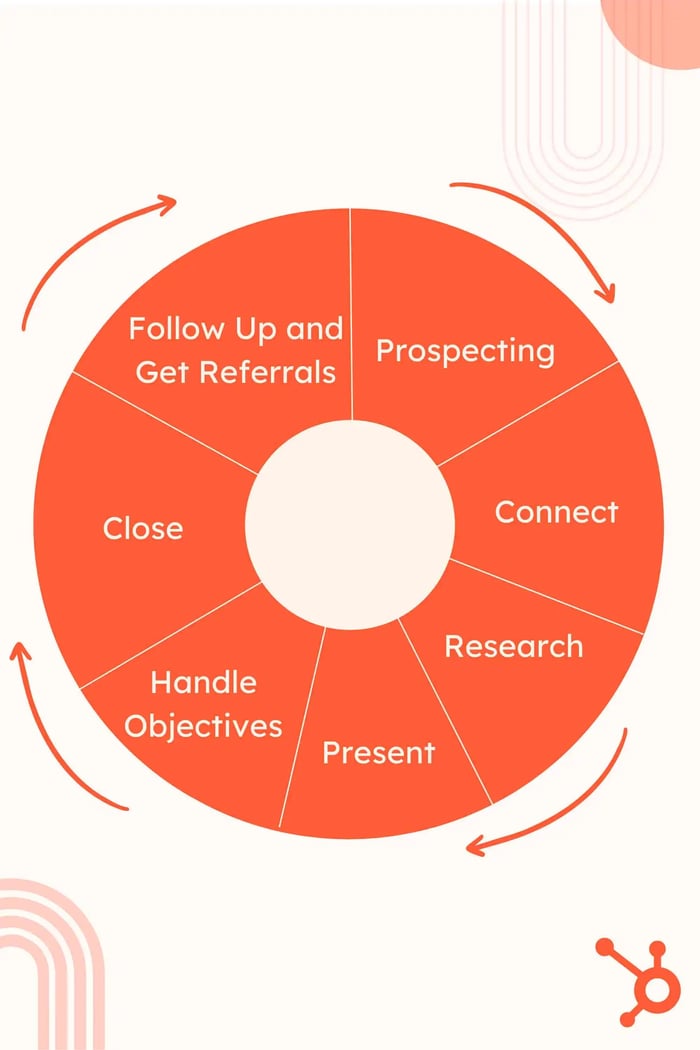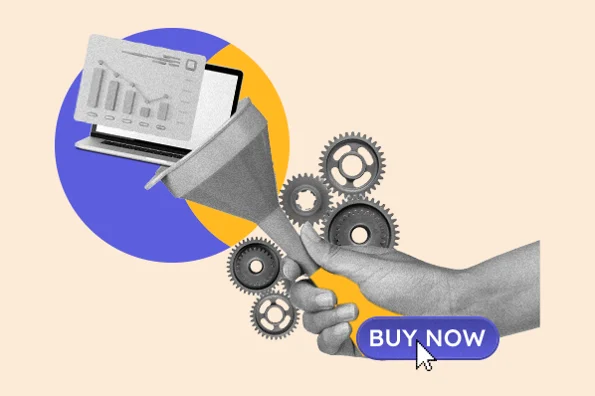Very few successful sales strategies revolve around throwing random tactics at the wall and seeing what sticks. Instead, you’ll need a clearly defined sales cycle to grow your business.

Sales cycles offer a regimented framework that lets your team know what to do as the customer moves through their journey. Here we'll learn what a sales cycle is, get a feel for the stages that typically comprise one, and how to effectively put one in motion.
Why should I have a process for my sales cycle?
Best Practices for Creating Your Sales Process
What is a sales cycle?
A sales cycle is the tactical process that a salesperson uses to convert a prospect into a paying customer. Sales cycles are often confused with sales methodologies — frameworks for implementing sales cycles. The sales cycle is more tactical, and often includes stages such as 'prospect,' 'connect,' 'research,' 'present,' and 'close.'
It's in your company's best interest to have a sales cycle in place. It allows you to better organize your sales pipeline, prioritize leads, and ultimately evaluate the efficacy of your sales efforts.
Having a clearly defined sales cycle gives your reps a common roadmap. Your reps need the flexibility and know-how to pick up where another left off — if need be. But, there's no "where they left off" if there's no sales cycle to guide their efforts.

A sales cycle also sets up the infrastructure for reps to prioritize leads and understand how far along prospects are in their buyers' journeys. If they can identify where they are in the context of a sales cycle, they'll know how to best approach the leads they're pursuing.
So, should your team have a sales cycle?
Salespeople treasure the art of improvising. They have to because it’s one of the few ways they can deal with highly unpredictable consumer demand.
However, building a common sales cycle for your organization can create cohesion and avoid confusion.
Here are three reasons we recommend having a sales cycle.
1. It makes your sales training process easy.
When you only rely on your sales team to learn new skills on their own, it takes time to have a consistent and structured training process. While your team will learn through trial and error, they must follow a clear path to secure success.
However, a well-defined sales process will create consistency throughout the sales cycle and help you build an effective training strategy.
Your trainees will know exactly which steps to take, how to execute them, and what results to expect.
2. It helps you structure your team right.
The sales cycle helps you to deliver a product or service that aligns with your prospects’ needs. With a sales cycle in place, you can better organize your company’s sales pipeline and prioritize leads.
A clearly defined sales cycle provides your sales reps with a roadmap that they can follow to land more business.
Following the sales cycle steps will enable your salespeople to identify predictable patterns within each customer and contextualize your company’s offerings based on those patterns.
3. It helps you track team performance.
While there’s no perfect sales process, we recommend including a sales cycle in your team’s structure precisely to track performance and analyze results. This helps ensure your sales team only closes deals they can support and sell profitably.
How did your reps do? What worked well for them? Where did things go wrong or right? Did they deviate from the cycle? What happened if they did?
Having perspective for evaluation is essential to understanding how both your reps and business are performing — a sales cycle provides just that.
To understand a sales cycle, you must understand its different stages. Here's a breakdown of each one.
Stages of a Sales Cycle
Designing your sales process to align with your prospects’ buying journey will help you reach your goals. A typical sales cycle includes the following stages.

1. Prospecting
In prospecting, you identify companies and people who are a good fit for your products and services, then develop them into leads.
The sales team establishes an association with potential buyers and develops relationships throughout this stage.
Identify sales-qualified leads (SQLs) who meet your criteria and make a judgment on how close they are to becoming an opportunity. At this stage, you will determine whether they’re a fit for your company.
2. Connect
After identifying your SQLs, you need to connect with those leads. Contact them directly to determine their current needs. Then, introduce your business and educate them on the value of your solution and how it can help them solve their problem.
You can do this in a variety of ways, including:
- Discovery calls.
- Outbound emails.
- Signup forms.
- Demo requests.
Present your product or service as an opportunity for them to achieve their goals. Emphasize your value proposition and show how it can help them meet their needs.
Make it simple for your leads so that they can understand what you’re offering, why it’s right for them, and that you can implement it.
3. Research
This is when you learn your prospect’s needs, goals, and challenges as much as possible. This research stage validates your assumptions and gets a better idea of what customers need.
A discovery or qualifying call is the best way to start this phase. It allows you to dig deeper and make an informed decision on whether your prospect fits your portfolio.
Before you hop on a call, create a list of questions to help you gain more insights into their business and industry. Some of these questions may include the following:
- What’s the budget for the project?
- What are your biggest challenges and opportunities?
- What’s the timeframe for this project?
Use a discovery call to assess whether you and your prospect are a good fit. Then, create a pain point plan to keep them on track through the sales cycle.
4. Present
In this sales cycle stage, it’s time to spark their interest and clarify your value proposition.
You’ll present to a team of decision-makers interested in your product or service and field questions from your prospects.
Present how your solution can help them achieve their goals and review your solution’s benefits. Gauge their interest and adapt your messaging to meet their needs.
5. Handle Objections
You should expect pushback from your prospects about the price or schedule for the project.
Listen intently to your prospect’s concerns, understand the context of their pains, and acknowledge their challenges. Your job is to address their concerns and handle their objections before they can sink your deal.
Overcoming objections involves answering questions about cost, timeline, resources, and service level agreements.
6. Close
Selling your solution decisively and efficiently is the key to closing the deal. It’s time to negotiate a mutually beneficial agreement for both parties.
At this stage, you can answer their questions about pricing and delivery differently depending on their reaction to your initial proposals. If you get pushback, work with them to refine the proposal until they agree.
Signal their agreement by asking if they are ready to move forward with you. If they agree, draw up a contract with your terms and conditions and sign it.
7. Follow Up and Generate Referrals
Landing a deal is only the beginning. To build long-lasting success, you must communicate with your clients and their teams to keep them up-to-date on your progress and deliver the results they expect.
Serve your new customers well while in your pipeline. A good customer experience ensures that your customers are happy and will spread the word about your expertise. And if you can, exceed their expectations and set your business apart from the competition.
Find opportunities to ask for customer referrals and feedback. Customers who are happy with your product or service will gladly tell everyone about it.
Best Practices for Creating Your Sales Process
When creating your sales process, you need to identify the specific steps of the selling cycle and which ones will help you close deals. Use these best practices when creating your roadmap.
Start with the consumer in mind.
A successful sales strategy involves knowing your customers’ needs, goals, and challenges. It consists of creating a value proposition that will address their pain points and keep them moving through the process.
Digital sales tools are essential but should only support the process. Ideally, you want to keep technology from dictating how you interact with your customer.
Align sales with your marketing team.
If your sales and marketing teams align, you can avoid selling a product that doesn’t fulfill the promise made during the marketing cycle. Sales and marketing should develop a cohesive strategy to help you get more leads and close more deals.
Use social proof.
The social proof effect is when your prospects trust the opinions of others who have purchased your product. As a salesperson, you influence this and could use this to your advantage by sharing positive feedback from previous customers.
Actively share case studies with your prospects to build their trust and show your ability to deliver.
Sales Cycle Management
Sales cycle management is how salespeople, managers, and leaders keep track of each stage of the sales process. They identify trends and determine which steps of the process are doing well or need to be improved.
If you're a salesperson or sales leader, sales cycle management allows you to evaluate the stages of the sales cycle to see where improvements or adjustments need to be made. Tools, like a CRM, aid in sales cycle management.
Sales cycles are a pivotal part of every salesperson's day. It's important to be familiar with the cycle your team abides by — and use it as your compass to navigate the storm that selling can be.







.jpg)


